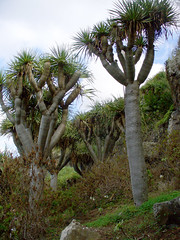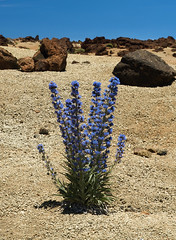by Nuria Serrano Vinagre
In this and next posts, we're going to give you a brief overview of Biodiversity on islands. First of all, a few questions:
Did you know most of the largest and smallest species on the world live on islands? For instance, Galápagos giant tortoise (Geochelone nigra), an example of gigantism, and Japanese wolf (Canis lupus hodophilax), an example of dwarfism (Extinct).
Of 592 species of birds, just Scottish Crossbill (Loxia scotica) is the only bird endemic species of United Kingdom (0’17%). However, Hawaii has got 322 species of birds, 53 of wich are endemic (16’2%), as for example 'I'iwi or Scarlet Hawaiian Honeycreeper (Vestiaria coccinea) or Hawaiian Goose or Nēnē (Branta sandvicensis). Why has Hawaii got a smaller number of species than United Kingdom but most of them are endemic?
Over the last 500 years, the majority of documented extinctions have been on islands, as opposed to mainlands, for instance for both terrestrial vertebrates and plants. Why most extinctions occur on islands?
In this review about Biodiversity on islands, we'll try to explain these and other facts. At first, we'll talk about special characteristics of this biodiversity. Then, we'll go on explaining the factors which determine the distribution of species on islands (Island biogeography). Finally, we'll analyze how extinction works on them.
I. Island ecosystems: characteristics.
Previous ideas
Before telling the ecological characteristics of islands, we would like to emphasize two main ideas:
- The isolation of the ecosystem causes the fragility of itself and the high rate of endemic species.
- The difference between continental and oceanic islands: The continental islands are bodies of land that lie on the continental shelf, and most of them are result of rift of the continent or entrance of seawater in it. Oceanic islands sit on the oceanic shelf and they are result of volcanic activity or bending of the plates during the tectonic movements. One of the key to understand the special biodiversity on islands is the origin of them. Having already or not fauna and flora at the formation of island is a deciding factor of the future biodiversity. For example, think about bird species in UK (continental islands) versus Hawaii (oceanic islands).We discuss about this in a next post, but keep these ideas on your head.
The 5 most important features of islands ecosystems are:
1. Smaller number of species than continental surfaces with the same area.
That's a logical consequence of their isolation.
2. Endemisms.
They have a high rate of endemism. There are 2 kinds of endemisms:
- Relicts, that means they survive on islands meanwhile on continental areas disappeared. For instance, Drago of Gran Canaria (Dracaena tamaranae) is an endemic relict to Canary Islands related to Drago (Dracaena draco).
Drago of Gran Canaria (Dracaena tamaranae), by scott.zona in Flickr (some rights reserved).
- Endemisms of new emergence by speciation on the islands. For example, Tajinaste Picante (Echium auberianum) is an endemic species to the top of Teide which emerged when the Canaries have been formed.
Tajinaste Picante (Echium auberianum), by Jörg Hempel, on Flickr (some rights reserved).
For instance, the most frequent case is the lack of predators. That's very important to understand the vulnerability of islands and other characteristics of these ecosystems. We go into this topic in depth in the next section and in a future post.
4. Gigantism and dwarfism.
How can we explain the increase and decrease of body size in island animals? In 1964, Foster J. B. proposed the called "Island rule", by which gigantism could be a consequence of lack of predators combined with a strong intraspecific competition, so bigger sizes would be selected. Dwarfism, in turn; coul be explained by lack of enemies in an environment with limited resourses, which could lead to a strong intraspecific competition, situation where smaller sizes would be favorable. However, this Foster's rule have been discussed many times, as for example by Case (1978) and Meiri et al. (2007), among others (see Bibliography).
5. Birds and insects without flying capacity.
Very common birds and insects who can't fly live on islands: they might lose their flying capacity when they arrived to islands or emerged on islands from birds and insects who could fly. This is the example of the Giant weta before, the Galápagos penguin (Sphenicscus mendiculus) or the Kiwi (Apteryx spp.)
That completes the most important features of island ecosystems. In a next post, we talk about Island Biogeography and a third and last post of this series will be about Extinction on islands.
There are a lot of example of giant and dwarf species from islands, as the Galápagos giant tortoise and Japanese wolf we mentioned before. Other example of giant species is Giant weta (Deinacrida spp.), an endemic "cricket" from New Zealand whitout wings and which can reach 20 cm long. In contrast, the Island fox (Uorcyon littoralis), an endemic species of Channel Islands to California which is the smallest fox to North America (70 cm long including the tail).
How can we explain the increase and decrease of body size in island animals? In 1964, Foster J. B. proposed the called "Island rule", by which gigantism could be a consequence of lack of predators combined with a strong intraspecific competition, so bigger sizes would be selected. Dwarfism, in turn; coul be explained by lack of enemies in an environment with limited resourses, which could lead to a strong intraspecific competition, situation where smaller sizes would be favorable. However, this Foster's rule have been discussed many times, as for example by Case (1978) and Meiri et al. (2007), among others (see Bibliography).
5. Birds and insects without flying capacity.
Very common birds and insects who can't fly live on islands: they might lose their flying capacity when they arrived to islands or emerged on islands from birds and insects who could fly. This is the example of the Giant weta before, the Galápagos penguin (Sphenicscus mendiculus) or the Kiwi (Apteryx spp.)
That completes the most important features of island ecosystems. In a next post, we talk about Island Biogeography and a third and last post of this series will be about Extinction on islands.
Bibliography and links:
- British Ornotologists' Union. 2010. The official list of birds of Great Britain.
- Case, T.J. 1978. A general explanation for insular body size trends in terrestrial vertebrates. Ecology, 59: 1–18.
- Consejería de Ganadería, Pesca y Medio Ambiente, Gobierno de Canarias (España). Banco de Datos de Biodiversidad de Canarias.
- Department of the Interior, United States of America Government. National Park Service.
- Foster, J.B. 1964. The evolution of mammals on islands. Nature, 202: 234–235.
- Margalef, R. 1993. Teoría de los sistemas ecológicos. Universitat de Barcelona.
- Meiri, S., Cooper, N., Purvis, A. 2008. The island rule: made to broken? Proc Biol Sci., 275 (1631): 141–148.
- Ministerio del Ambiente, Gobierno de Ecuador. Dirección del Parque Nacional de Galápagos.
- Ministry of Culture and Heritage, New Zealand Government. New Zealand's natural environment.
- Pianka, E. R. 1978. Evolutionary ecology. Harper & Row.
- Pyle, R. L. 2002. Checklist of the birds of Hawaii. Elipaio, 62: 6.
- Sax, D. F. & Gaines S. D. 2008. Species invasions and extinction: The future of native biodiversity on islands. PNAS, 105: 11490-11497.
- Wihttacker, R. J., Fernández-Palacios, J. M. 2007. Island Biogeography: ecology, evolution and conservation. Oxford University Press.



No hay comentarios:
Publicar un comentario